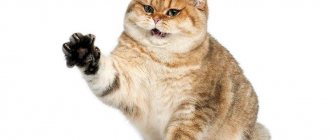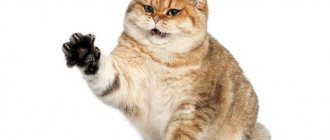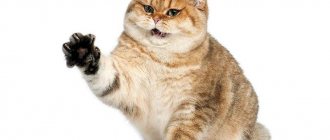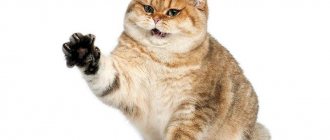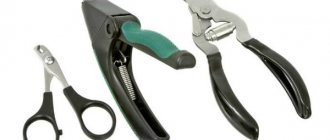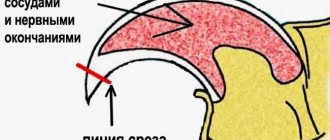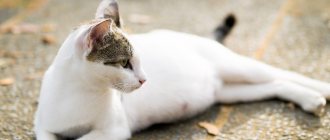For many domestic cats, nail trimming is a must. Growing nails cause discomfort to animals, and if they are not shortened in time, inflammation may begin. However, you need to properly prepare for a cat “manicure” and learn the technique of performing it. Then the procedure will take place with minimal stress and will not cause pain to the cat.
Which animals are not recommended for the procedure?
There is no need to trim the claws of a cat that roams freely outside. She needs her nails to climb trees, hunt and defend herself from other four-legged animals.
Also, the procedure is not performed on kittens under 1 month of age. Their claws are not yet formed. Early cutting negatively affects the structure of the nail plate and leads to delamination.
But already at 2 months the claws are strongly extended, and the kitten begins to scratch. At this time they can already be cut.
What if it doesn't work out?
It is possible that the cat will turn out to be too obstinate, and many days of efforts and tricks to accustom it to manicure will be in vain. In this case, contact a specialist at a veterinary clinic or grooming salon. But keep in mind that such visits can be stressful for a furry creature.
Think about what exactly you didn’t like about the cat’s claws? If the problem is solely in scratched furniture and wallpaper, purchase several scratching posts, saving your pet from negative emotions.
What tools can you use?
There are special nail clippers for trimming cat claws. It is not recommended to use nail scissors. They are designed for thin and flat nail plates of people. Such cutting tools lead to delamination.
There are several types of nail clippers:
- Blisters - resemble nail scissors, but have blades curved at the ends, designed for cat claws.
- Secateurs are equipped with a spring, which is located between the handles. As a rule, such models have a limiter. It allows you to cut only the desired length.
- Guillotines are similar to cigar scissors. The nail is placed in the hole at the end. When the handles are closed, the blade lowers and cuts the claw. The tool is suitable for cats with thick nail plates.
Each owner chooses the model that is convenient for him to use. The main thing is that it is made of high-quality materials and sharpened.
Additionally, you can buy an electric trimmer that allows you to quickly trim your nails. However, not all cats react calmly to it - the buzzing device scares the animals.
Important. When cutting, the blade of the guillotine nail clipper must move from bottom to top, otherwise the risk of crushing the nail increases. This is especially dangerous for kittens whose claw plates are not yet strong enough.
Do I need to trim my cat's claws?
A cat's claws continue to grow throughout their lives and the animal constantly grinds them down so that they do not exceed normal length. Yard cats and those who often walk outside use tree trunks or asphalt for this.
Indoor cats are forced to make do with furniture surfaces and door frames. As a result, scratches are found on them, the coating deteriorates, like upholstered furniture.
Claws that are too long can grow into your cat's paw pads and cause pain when walking. To prevent this, you need to shorten your pet’s claws or purchase a special device - a scratching post. Although in the latter case it is necessary to raise the cat so that he uses it exclusively.
How often is nail trimming done?
The frequency of haircuts depends on the individual characteristics of the cat. For some, it is enough to carry out the procedure once a month, for others – every 2-3 weeks.
As a rule, light-colored nails grow faster. And in cats that prefer active games, partial wear occurs naturally. To determine the exact timing, you just need to carefully observe your pet.
For your information. A cat needs to have its claws trimmed before an exhibition, competition or other important event.
How to trim a cat’s claws: getting ready and carrying out the procedure correctly
Inexperienced owners think that trimming a cat’s claws is a difficult and unnecessary task. There may be some justice in this approach, but a responsible owner must have certain skills, and painless nail trimming is one of them.
Do cats need manicures?
Nobody cuts the claws of wild cats, but in (civilized) zoos even lions get a manicure, and the claws are not only trimmed, but also filed. This procedure is mandatory and is explained by a number of reasons. Cats' claws grow constantly, that is, if they are not worn down or trimmed, then problems cannot be avoided.
Another argument emphasizing the uselessness of the procedure: in villages and cities, many cats live without manicure and maintain their claws in order on their own. Yes, it's true, most animals know how and enjoy caring for their claws. A cat's daily diet includes cleaning and sharpening its claws.
Cats whose skills have been dulled need meticulous care. For the most part, this applies to artificially bred breeds. Some animals have a genetic predisposition to rapid growth of claws, that is, the cat simply does not have time to wash them, even though she leads an active lifestyle.
Let’s make a reservation right away: if you trim a cat’s claws correctly, there is nothing dangerous or painful in this procedure. Moreover, many pets need (!) their nails trimmed to prevent ingrown nails. Claws that are too long bend, and their tips become like sharp hooks. The cat knows how to retract its claws, but to a certain length, and if these hooks look out of the sinuses, they cling to upholstered furniture, the owner’s clothes and carpeting. Tights and marks are not so bad, the main thing is that the pet experiences discomfort, walks unsteadily, and if he pulls his paw too hard, he risks injuring his finger.
If you notice that your cat has begun to dig at the floors and walls (usually at night), this is a clear sign that her nails are too long.
Unlike some dogs, all mustachioed tabby dogs have fifth toes on their front paws. These fingers are mobile and functional, and the claws on them serve as an additional tool. The claw on the fifth toe does not wear down naturally. In most outbred cats, the claws on the fifth toe only grow to a certain length, but there are exceptions. A claw that is too long curls toward the paw, pricks and pierces the skin. It is easy to imagine how quickly a wound will become infected.
Conclusion: whether your cat personally needs a manicure is up to you to decide, but according to general rules, nail trimming is a mandatory grooming procedure.
It would be convenient if with each animal the owner was given instructions - what to feed, when to bathe, how to play... in practice, each owner gains skills through trial and error. Based on the experience of owners and veterinarians, we can conclude that the frequency of claw trimming depends on a number of factors, and here are just some of them:
- Lifestyle – a cat that goes outside has the opportunity to actively grind its claws. Lazy couch cats need more frequent manicures.
- Genetics – Some pets are prone to extremely rapid nail growth.
- Balanced diet - if the diet lacks microelements, claws grow more slowly.
- The presence of cat accessories - scratching posts, special rugs and posts with which the cat plays, this is a tool for grinding down the claws.
- Pigmentation - it is believed that light claws grow faster than dark ones.
The rate of nail growth for each cat is individual and depends on a number of factors. Shearing is carried out strictly as needed, on average once every 2–4 weeks.
A word of caution - don't trim your pet's nails just for convenience. Unfortunately, some owners often trim their cats' claws out of fear for the integrity of the furniture or injury. It is better to think about material damage before getting a cat, and if you are afraid of serious scratches, you need to raise a pet.
There is an alternative, although not the best, but quite adequate - caps for claws. Silicone caps are attached with glue and serve as a temporary measure, for example, to ensure the safety of a child while meeting a cat.
Tool selection
A professional “with a full hand” can easily trim a cat’s claws with ordinary scissors, but for beginners it is better to use a special nail clipper. The problem is that the structure of a cat's claw is not as simple as that of a dog or a human. The finger and claw are a complex mechanism that includes not only joints and ligaments, but also large blood vessels. Thanks to such a complex device, tailed animals can hide and extend their claws at will.
Without going into the depths of cat anatomy, we can say that the claw consists of two parts: keratinized and living. You can cut only the tip, and if you catch the living part, you will not be able to do without bleeding. In addition, when a living part is injured, large nerve bundles are excited, and the cat experiences severe acute pain. If it happens that the claw was cut too short, the cut should be treated with antibacterial solutions until it is covered with a layer of keratinized tissue.
To carry out the procedure at home, veterinarians recommend using a specialized instrument. The experiences and reviews of owners vary greatly, as everyone chooses a more convenient accessory and approach for themselves. So, if you are going to trim your cat’s claws yourself, you can use:
- Using stationery scissors - as mentioned above, if you are not experienced, there is a high risk of damaging blood vessels.
- Nail clippers are a safer tool, which, although not intended for animals, will allow you to trim and blunt only the tips of the claws. When using tweezers, you need to hold them perpendicular to the claw; if you press at an angle, the nail plate may crack.
- The guillotine is the most suitable tool for a beginner. The full name of the accessory is a guillotine-type trimmer. The advantage is that the claw is trimmed in one motion along a precise line. It is important that the trimmer is of high quality, since cheap accessories quickly become dull.
- Veterinary tongs are a hybrid of manicure tongs and a guillotine; they are convenient because they have handles that fit well in the hand.
- Special scissors (clave clipper) - they look like stationery ones, but at the ends of the blades there is a clip that carefully clasps the tips of the claws.
For the procedure, you need to prepare a first aid kit, at least cotton swabs and a solution to stop bleeding. No one is immune from mistakes, and if the claw is damaged, help must be provided quickly and competently.
In any large pet store you will find many models of accessories, but the mechanism of action for most of them will be similar - guillotine. When choosing such a tool, it is recommended to sharpen the cat’s claws after trimming with a special file or whetstone. If you buy a file in a regular store, choose a dense one, with a fine cross-section, but high rigidity, since cat claws are much harder than human ones.
If you are afraid of hurting your cat, it is better to entrust the first procedure to a veterinarian.
You can take your pet to the clinic or have it groomed at home. In any case, in experienced hands, your cat will get a manicure in literally 3 minutes.
Preparatory activities
Some owners are simply forced to take their cat to the doctor or to a nail trimming salon. The fact is that not every adult purr will allow its claws to be trimmed. On forums people often ask for advice on how to trim a pet’s nails if it breaks out or bites. Hypothetically, there are two options: give the pet a sedative and take advantage of his calmness, or accustom the cat to the procedure. Naturally, the first option is acceptable only if the situation is urgent.
Accustoming a cat to the grooming process should begin from childhood. There is no need to trim your kitten's claws, but it is necessary to familiarize him with the tool and the process itself. Repeat the algorithm when you have a free minute:
- Take the baby in your arms, stroke it and voice your intentions: “Now we’ll trim the claws, don’t be afraid.” Try to speak softly but confidently, don’t worry, your pet will feel it.
- Place your baby on the table and move the tool that you will use to trim his nails in the future. The baby will be interested in the accessory and needs to be encouraged.
- When the kitten sniffs the nail clipper and stops paying attention to it, pick up the kitten's paw.
- Click on the pad to reveal the claw. Touch it with the coterez. Repeat with all fingers and praise the kitten for each calmly accepted touch.
- When the previous point does not cause embarrassment, click the nail clipper next to the claw after making contact. Your baby will probably be scared the first time, but your praise and reassurance will calm him down.
Training an adult cat follows a similar algorithm, but there is some difficulty. A kitten is happy to do any activity together, even something strange, but you need to train an adult cat by adapting to its mood. If your pet is irritated, and you come at her with an incomprehensible clicking thing, she is unlikely to perceive the training process as a positive activity.
The procedure itself is not as complicated as it seems, but it requires attention and caution. Separately, it is necessary to say about cats with dark claws. The richer the pigmentation, the less visible where the living part of the claw begins. Try shining a flashlight on the claw; if that doesn’t help, contact a professional; don’t cut it at random. If you don’t have the opportunity to see a veterinarian, and “you need to do something” with your claws urgently, use a nail file.
Try to keep it clean. At a minimum, wash your hands and sanitize the instrument, even if it has just been taken out of the package. There is no need to treat the claws, but if your cat goes outside, it is advisable to wash its paws. Have clean napkins, sponges and a towel on hand. For the first procedure, we recommend preparing a first aid kit for yourself: sponges, brilliant green, bandage, cotton swabs.
Tip: the cat will be calmer if she understands what is happening, so the claws on the hind legs are cut after the front ones.
Be gentle but confident; your hands should control the cat's movements. If the pet pulls its paw at the wrong moment, the guillotine will hit the air, but if the claw is deeper under the blade, trouble will happen. Both of your hands will be busy, one will have a tool, the other will have a cat's paw, so for the first procedure it is better to enlist someone's help.
When you press on the pad of your finger, the claw is completely exposed. Examine it from the side, so you will accurately mark the border beyond which the vessels are located. The pink, live area contains nerve bundles, so if you accidentally damage the claw, the procedure should be stopped. The cat will be in pain and it will most likely not be possible to trim the remaining claws without harm. Some owners advise cutting all the nails at the beginning, and only then filing them.
Trim only the tips of the claws, that is, you need to leave at least 2 mm of keratinized tissue between the cutting line and the living part of the claw. Immediately after cutting, sharp corners will remain in the place of the cuts, which are rounded off with a sanding file. Run your claw over a napkin with a tenacious structure and ensure that there are no burrs on the claw. Was everything successful? Praise your pet and move on to the next claw. Take it step by step. If the cat becomes nervous, stop the procedure. There is nothing wrong with continuing your haircut the next day, but the negative emotions associated with the procedure are quite difficult to overcome.
The cat needs to be praised after each successfully trimmed claw, even if it twitches, but bites and scratches need to be stopped - that is, stop, straighten the cat and try again.
What to do if your cat is aggressive?
The main problems arise when you need to trim the nails of an aggressive cat. Let us immediately make a reservation that in such a situation there is no place for self-confidence, since an angry pet can cause serious injuries. The first thing you need to do is find an assistant, or better yet two. One person will hold the cat, a second will trim the claws, and a third will manage the emergency first aid kits.
So, we take it as an axiom that a cat needs to trim its claws, even if it doesn’t give in, hisses and bites. A method that has been proven over the years and by thousands of owners involves using a small, durable (sports) bag. The purpose of the bag is that paws can be placed in it, the claws on which are not cut. If you have a strong and dexterous helper, you can wrap the paws in a towel.
Before the procedure, the animal needs to be given half the dose of any veterinary sedative, because our goal is to accustom the cat, and not to cut its claws once and forget about it. Your assistant takes the cat by the skin on the shoulder blades (scuff) with one hand, and with the other holds a bag, towel or fold on the cat's lower back. At this stage, the main thing is not to scare the animal even more, because the pet understands that you are planning something terrible.
Try to act quickly and confidently, but do not forget to talk to the animal. If necessary, divide the procedure into several approaches so that the pet can rest. If the cat loses its temper and starts attacking you, it needs to be isolated in the room for 10–15 minutes, and the procedure should be continued in the veterinarian’s office. It’s mysterious, but true - when a veterinarian trims a pet’s nails, there is practically no resistance. Apparently, the reason is that the animal is in an uncomfortable environment and in the hands of a stranger.
A small fluffy kitten in the house is not only a great joy, but also a huge responsibility, because the pet needs careful care. And, if most cats perceive procedures such as bathing and brushing favorably, then trimming claws turns into a real problem not only for animals, but also for their owners. Let's try to figure out why you need to trim your cat's claws, whether it can be done at home, and what tools are needed for this.
Preparing for the first procedure
To trim a cat's claws with minimal stress, the animal is first accustomed to this procedure. It is better to start doing this in childhood. Kittens adapt to any changes more easily than adults.
For your information. There are cases where adult cats, accustomed to clinging with their claws while jumping, have fallen and been injured due to the fact that their nails were suddenly cut.
Preparations for grooming begin at a time when the cat is not doing anything (not playing, licking itself, eating or sleeping). They take her in their arms and stroke her affectionately.
Then they carefully move to the paws - they try to touch, lightly massage, imitate a haircut. At the same time, they talk to the pet and try to switch its attention to something interesting so that it does not break out.
As a rule, kittens do not like to have their paws touched, so the first 2-3 times they will get irritated and run away. But if you regularly repeat this exercise, the baby will get used to the manipulations. To reinforce the positive associations, he is given a treat at the end.
When the kitten begins to be calm about being touched, they begin to “rehearse” the haircut itself:
- put the pet in the desired position;
- take each paw in turn;
- examine the nails, press on the pads.
If the kitten tolerates all the actions, he is sincerely praised.
Then the pet is introduced to the nail clipper. It is important to show that the tool does not pose any danger. After the animal begins to treat him calmly, you can cut the kitten’s claws for real.
Getting to know the nail clipper
Ideally, your cat should be introduced to this tool at a young age. She needs to stop being afraid of the sound of the nail clipper before you try to use it. A simple exercise will help you.
Place the animal on your lap. Take a piece of uncooked spaghetti and place it in the nail clipper. If the cat's curiosity prevails and forces you to sniff, place a treat on top. Massage the pad of your finger, release the claw and cut the spaghetti. Immediately release your paw and offer your pet a treat so that the click evokes pleasant associations.
Repeat the exercise until you become completely accustomed: you should not start trimming your nails until you achieve complete trust and mutual understanding.
Step-by-step instruction
A cat's claws consist of a keratinized layer, inside of which there is a pulp - a collection of nerve endings and blood vessels. When trimming, it is important not to touch a sensitive area, otherwise it will be very painful for your pet and blood will come from the wound.
In cats with light-colored claws, the pulp is clearly visible - it looks like a pink, crescent-shaped area. You can point your paw at a bright light or use a flashlight - the picture will be clearer.
It is more difficult to trim the claws of cats with dark pigmentation - you will have to act blindly. In this case, carefully cut off 1-2 mm at a time until the color inside becomes a little lighter - this is the beginning of the pulp.
For your information. Before cutting, remove the hair between the pads so that it does not interfere.
Nail trimming begins when the cat is calm, relaxed and ready to communicate. At this point, the owner should disinfect his hands and nail clippers, prepare cotton pads and antiseptic in case of injury.
Step-by-step instructions for trimming nails at home:
- The owner takes a comfortable position, puts the cat on his lap with his back to himself or lays him on his back. Particularly mobile pets can be wrapped in a terry towel.
- He takes the paw in his hand and presses on the pad to expose the claw.
- He brings the nail clipper to his paw. If the cat does not show concern, clicks it. In case of anxiety, he strokes and calms the pet, after which he repeats the manipulation.
- Now quickly and confidently sets the nail cutter 1-2 mm to the pulp and trims the claw so that the edge remains sharp. If you cut the platinum at the wrong angle, you will be more likely to hit the pulp.
- At the end, the cuts are rounded off with a nail file, giving a natural shape. In the future, you will be able to trim your claws less frequently if you regularly trim the overgrown areas.
If you trim your cat's nails correctly, your cat will not experience any discomfort. In fact, many animals struggle and hiss not because of pain, but because they are scared.
In order not to overwork the cat, the haircut is carried out in several passes. For example, one paw is treated daily.
Why trim your cat's claws?
For many generations, domestic cats were excellent at catching mice - they simply needed claws. In addition, spending most of their time outside, they could use any tree or fence to “sharpen their claws,” but in fact, remove the upper, exfoliated section of the claw. In addition, active running “over rough terrain” also contributed to the claws of wild and semi-wild cats grinding down on their own.
What should modern domestic cats do, who see nature only from a window or a carrier? City streets have become dangerous for domestic animals: toxic chemicals, salt sprinkled on roads, flayers and feral dogs. A caring owner will think three times before letting his pet go into this “jungle”. All that remains is a scratching post and the master's sofa. Some cats try to help themselves with their teeth, but their teeth are not at all designed for such delicate work.
Overgrown claws are a threat not only to upholstered furniture and carpets. During the game, the animal becomes simply dangerous. Without meaning to, a cat can severely scratch its owner or other family members or animals. And scratches from cat claws take a long time to heal, and there is a high risk of infection and suppuration. The cat becomes dangerous to itself. Trying to scratch or wash her face, she can scratch the skin, or even touch the sensitive skin of the ears or the cornea of the eyes.
Cats have 5 claws on their front paws, and the fifth is located high and practically does not take part in “scratching” and does not touch the surface when walking. If you don't trim it, it can grow so long that it simply curls up and grows into the skin. Unpleasant and painful, real surgery will be required to help your pet. To avoid all these troubles, you need to trim your cats' claws regularly and in a timely manner.
What to do if the animal is not given
To trim the claws of cats that categorically refuse this procedure, they use fixing overalls. They provide access to all limbs, but do not allow the pet to move freely.
At first, it is advisable to carry out the haircut with an assistant who will hold the animal. If the cat meows loudly and struggles, take a break. Let her rest and calm down for a while, then you can try again.
Important. You should not swear or shout at a cat if it resists while trimming its claws. Aggression from the owner will only frighten her. In the future, the pet will try by all means to avoid the unpleasant procedure.
How to trim a kitten's claws correctly?
This procedure is quite unpleasant for the animal, so kittens often resist and do not allow their owner to perform a neat trim without unnecessary problems. If the kitten has long hair that completely covers the nail, then trimming becomes more difficult. In addition, it will constantly break out.
Let's look at expert advice on how to trim a kitten's claws without hurting him or yourself:
- It is better to start trimming from an early age, the kitten will gradually get used to it and will more calmly endure this unpleasant process;
- when you caress and stroke your furry pet, apply slight pressure to the paw pads so that he gets used to such a touch and does not resist when trimming;
- This procedure should not be carried out when the animal is hungry or too active; choose a moment when the cat is drowsy or sleeping;
- If the animal shows aggression, it is better to postpone the planned care activity for a while.
4 stages of nail trimming:
- feed the kitten and try to calm it down;
- stroke and cuddle your beloved pet;
- Gently press on the pad of the paw and trim the tip of the claw using special clippers for this purpose. After trimming, it is recommended to smooth the cut area. A scratching post is used for this;
- If during the procedure you accidentally injured your pet's paw, treat the wound with hydrogen peroxide;
If the cat is not given?
Cats, like people, have different types of personalities. There are particularly nervous and aggressive animals that do not even allow the owner to touch their paws. Alternatively, nail trimming for these pets should be done by two family members, one holding the cat and the other trimming the nails. You can also swaddle your pet with a soft towel or sheet.
If the cat still behaves aggressively and stubbornly breaks out, you should not use force, since trimming the claws can lead to paw injuries. It is better to interrupt the procedure and do it when the pet is in a calmer state.
